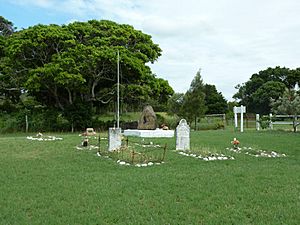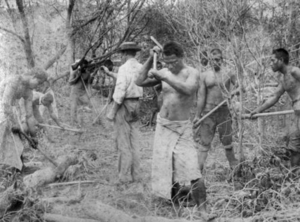Joskeleigh Cemetery facts for kids
Quick facts for kids Joskeleigh Cemetery |
|
|---|---|

Joskeleigh Cemetery, 2001
|
|
| Location | Joskeleigh Road, Joskeleigh, Shire of Livingstone, Queensland, Australia |
| Design period | 1870s - 1890s (late 19th century) |
| Built | 1890s - 1900s |
| Official name: Joskeleigh Cemetery, Sandhills Historical South Sea Islander Cemetery | |
| Type | state heritage (built, landscape) |
| Designated | 21 October 1992 |
| Reference no. | 600659 |
| Significant period | 1890s- (social) 1890s (fabric) 1890s-2001 (historical) |
| Significant components | cemetery, grave surrounds/railings, memorial - rock/stone/boulder, headstone, trees/plantings |
| Lua error in Module:Location_map at line 420: attempt to index field 'wikibase' (a nil value). | |
The Joskeleigh Cemetery is a special burial ground located in Joskeleigh, Australia. It was built between the 1890s and early 1900s. This cemetery is also known as the Sandhills Historical South Sea Islander Cemetery. It is important because it tells the story of the South Sea Islander community in the area. The cemetery was added to the Queensland Heritage Register in 1992.
Contents
A Look Back: Joskeleigh History
The Joskeleigh Cemetery started on private land in the late 1890s. It was used by the local South Sea Islander community. By 1983, some families living in Joskeleigh were fifth-generation descendants. Their ancestors came to the Rockhampton area in the late 1800s.
South Sea Islanders in Queensland
From 1863 to 1904, South Sea Islanders were a main workforce in Queensland. They worked in the sugar industry. Many also worked in farming and on ships. About 50,000 Islanders came to Queensland during this time. Many signed up for work more than once.
After Australia became a federation in 1901, a new law was passed. This was the Pacific Island Labourers Act 1901. It meant that bringing South Sea Islanders to work would stop in 1904. Most Islanders were to be sent back to their home islands by 1907.
Between 1904 and 1908, over 7,000 Islanders were sent home. However, about 2,000 to 2,500 Islanders were allowed to stay. They became Australian citizens. Today, their descendants number around 15,000 people.
Settling in Joskeleigh
Islanders first came to Queensland to work in cotton and on farms. Later, they worked on sugar plantations along the coast. They helped clear land before planting sugar cane. Around Rockhampton, large sugar farms were set up. These were in areas like Yeppoon, Farnborough, Cawarral, and Joskeleigh.
When the government started sending Islanders home, many chose to stay. Most settled in the Keppel Sands area, which is now Joskeleigh. This area has a long beach and is close to Rockhampton. By 1914, about 200 Islanders lived there. The Joskeleigh School opened in 1915. By the 1930s, the population grew to about 250-300 people.
The Islander community first rented land from a local storekeeper, Bill Cuff. They built traditional huts using grass and tree bark. They soon became self-sufficient. They grew crops and market gardens to feed their families and earn money. Their families grew up there. Soon, they began buying their own land.
Community Life and Traditions
The Islanders kept their traditional skills alive. They were good at fishing, making nets, using natural medicine, gardening, and building. These skills were even taught in the local school. This helped the community stay strong and proud of their culture.
Between 1901 and 1914, many Islanders became Christian. Missionaries from Rockhampton taught them. However, they also kept many of their island customs and spiritual beliefs.
When someone died, the community held a special gathering called a wake. In the past, this celebration lasted for three days. A huge feast was prepared in the island style. It was a happy time, celebrating that the person's spirit had gone to a better place.
Graves were often decorated with glass ornaments and shells. Families used these because they were inexpensive. Shells were also used to decorate garden beds.
Preserving the Cemetery
The Joskeleigh Cemetery is mainly for the first generation of Australian Islanders. Twenty-two people are buried there. Most are Islanders, but one English woman who married into the community is also buried there. Some stories suggest there are other unmarked graves outside the cemetery's current area.
The burial ground was on a large piece of private land. It seems it was not used much after the Islander community bought their own land. By the early 1980s, the cemetery was badly damaged. Farm machines had bulldozed some graves. Headstones were broken, and fences were burned.
This upset the Joskeleigh residents whose family members were buried there. So, the local Islander community, led by Mrs. Mabel Edmund, took action. They asked the National Trust to protect the site in 1981. In 1983, they formed the Joskeleigh Historical and Progress Association. Their goal was to save the cemetery.
They started raising money. They also tried to buy the land where the graves were. These talks were not successful. So, Mrs. Edmund and the Association asked the Queensland Government for help. They asked the government to take over the land and make it an official cemetery reserve. This happened in 1984.
The State Government bought a quarter acre of land around most of the graves. This was to protect it as a historical site. The Joskeleigh Historical Society looked after the land. Now, the Livingstone Shire Council manages it. The community also helps maintain the grounds.
Not much restoration happened until 1991. Then, graves were marked. Headstones were put back up where possible. A stone monument was built with a plaque listing all those buried there. A fence and gates were added, and a sign was painted.
The most recent burial in Joskeleigh Cemetery was Mrs. Evelyn Warcon in 2001. Today, the Joskeleigh Cemetery is an important and beautiful part of the area. It is a source of pride for the community. It is also a lasting reminder of the South Sea Islander heritage.
What the Cemetery Looks Like
The Joskeleigh Cemetery is about 40 kilometers (25 miles) from Rockhampton, right on the coast.
The cemetery covers about a quarter of an acre. It was once part of a much larger piece of land. To the north, it is next to Joskeleigh Road. On the other sides, it is surrounded by private land with old trees. These include mango and pine trees. All the headstones inside the cemetery face east.
A large memorial stone has a plaque with the names of those buried there. Some stories say that a few Islanders are buried outside the current cemetery boundaries.
Many graves are decorated with glass ornaments and shells. Shells were often used to decorate graves and garden beds. Some graves have wooden crosses. There are also several marble headstones. One of these has a metal fence around the grave.
A wooden rotunda (a round, open building) is also located within the cemetery. A timber fence surrounds the cemetery, and you can enter from Joskeleigh Road.
Why Joskeleigh Cemetery is Special
The Joskeleigh Cemetery was added to the Queensland Heritage Register on October 21, 1992. This means it is recognized as a very important historical place.
Showing Queensland's History
The cemetery helps us understand Queensland's history. It shows how Joskeleigh became a settlement mainly for South Sea Islander people. These families owned or leased land, farmed it, and lived there since the 1890s.
The Joskeleigh Cemetery is a well-known landmark. Its graves, markers, and headstones are set in a neat lawn. The surrounding area has old trees like mango and pine trees. All of this makes the cemetery a beautiful place to see.
A Rare Part of Our Culture
The Joskeleigh Cemetery is quite rare in Queensland. It is one of the few places that is mainly the final resting place for South Sea Islander people.
A Typical Burial Ground
The cemetery shows what a small burial ground is like. It does not have separate sections for different religions. Most of the people buried there have a connection to the local area.
Important to the Community
The Joskeleigh Cemetery is very important to the local community. It has a strong connection for the descendants of the early South Sea Islander families in Joskeleigh. It helps them connect with their heritage and the experiences of their ancestors in Queensland.


